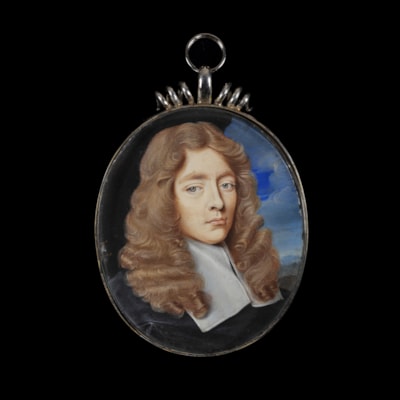PETER OLIVER
(c.1594-1647)Portrait miniature of George Villiers, Marquess of Buckingham, later 1st Duke of Buckingham (1592-1628), wearing black silk doublet slashed to reveal white and falling lace ruff; circa 1620
Circa 1620
5.3 cm (2 ¹/₈ inches) high
Watercolour on vellum
Later silver frame
SOLD
The purplish background is also similar to variants by John Hoskins of Buckingham, taken from the large family group by Gerard van Honthorst (versions in the Royal Collection and Collection of his Grace The Duke of Buccleuch). Here Buckingham also wears a black doublet slashed with white, but with a lace collar datable to 1625, around five years later than the falling lace ruff shown in this miniature..
Buckingham, who was praised for his charm, good looks and fine figure (a contemporary named him ‘the handsomest-bodied man in all of England’) quickly became a favourite of James I. Under James he rose from the title of Viscount Villiers in 1617 to Earl of Buckingham before being awarded a Marquisate in the following year. When questioned about his admiration for George Villiers, the King, who referred to his favourite as his ''Sweet Steenie'', is said to have responded by proclaiming, ''You may be sure that I love the Earl of Buckingham more than anyone else…Christ had his John, and I have my George''.
Peter Oliver had taken on the mantle of Court Limner from his father, Isaac, who had died in 1617. Peter had been trained alongside his late father and worked for Charles, Prince of Wales, while his father James I/VI was still patronising Nicholas Hilliard until his death in 1619. The present work, dating from circa 1620, is possibly one of the earliest images painted by Peter Oliver which unites the court of King James and his son Charles. Likely a private image for the aging king, Buckingham here is shown in relatively modest dress, with no distractions from his face. Unlike other miniatures of Buckingham, this portrait appears to have been taken from life and not based on an oil painting.
By the time this portrait was painted, Buckingham's relationship with the twenty year old Charles, Prince of Wales, was blossoming. Perhaps recognising that his old master was weakening, he turned his attention to the prince who was eight years his junior. 1623 the pair travelled to Spain to find a suitable royal match, but this was thwarted by Buckingham’s disgraceful behaviour abroad. He also tutored the young Prince in dance and in the year of James’s death (1625) he visited France where his efforts to physically seduce Henrietta Maria, Charles’s future queen, went as far as breaking into a royal garden and attempting to sexually assault her.
Despite fierce opposition by Parliament to the Duke's ever-increasing status and his readiness to declare war on France and Spain, his influence was not diminished by the death of King James in 1625. Although he bore the responsibility for engineering a marriage between Charles I and Henrietta Maria, a prospect which led indirectly to a badly managed war with Spain, calls for Buckingham's dismissal went unheeded by the King. Buckingham’s assassination in 1628 was almost certainly a result of the growing national resentment towards his perceived incompetence and corrupt rule.
[1] A portrait miniature at Welbeck Abbey in the collection of the Duke of Portland houses a miniature of a gentleman also described as 1st Duke of Buckingham, wearing near identical clothing.
Sold, Sotheby’s London, 11 July 1983, lot 99 (as a gentleman, traditionally identified as Robert Devereux, 3rd Earl of Essex, circa 1620);
Private Collection, UK.

shipping notice
Worldwide shipping is included in all prices.
The Limner Company does not accept any responsibility for import duty, this is to be paid by the buyer.
Some stock items contain materials from endangered species which are governed by CITES regulations and will require a permit to export outside of Great Britain. If a certificate of export is required then this will be the responsibility of and paid for by the buyer .
you may also like













